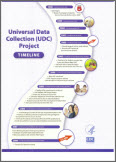Universal Data Collection (UDC) System

One of the major challenges facing scientists who work on rare disorders, such as hemophilia, is the lack of uniform health data. To address this issue and to advance health research, CDC created a national public health surveillance project called the Universal Data Collection (UDC) system. UDC was carried out in collaboration with federally funded hemophilia treatment centers (HTCs) in the United States and its territories.
During the system’s operation from 1998-2011, about 27,000 people with bleeding disorders contributed their health data by participating in the UDC program. More than 80% of all people with hemophilia who received care at HTCs during that period participated in the study. When UDC ended, it was followed by the Community Counts program. Community Counts aims to continue and expand on the work of the Universal Data Collection system.
Learn more about Community Counts
For details about UDC and how it compares to Community Counts, click below to show a table comparing the UDC and Community Counts.
| System details | Universal Data Collection system | Community Counts system |
|---|---|---|
| Time frame | 1998 through September 2011 | October 2011 to present (however, the full data collection system was not implemented until 2013) |
| Primary focus |
|
|
| Data source | Federally funded HTCs | Federally funded HTCs |
| Patient registry: types of data reported on clinical forms |
|
|
| Laboratory specimens and tests |
|
|
| Funding | Cooperative agreement awarded to 12 HTC regional centers | Cooperative agreement awarded to ATHN to serve as Community Counts coordinating center; ATHN administers subcontracts with HTC regional centers, which then administer contracts to individual HTCs |
| Partnerships |
|
|
| System components |
|
|
| Consent for registry participation |
|
|
| Patient registry clinical data forms |
|
|
| Patient registry data submission |
|
|
| Laboratory specimen shipping timeline | Centrifuged and shipped to CDC on cold packs within 30 hours of blood draw | Centrifuged and shipped to CDC on cold packs within 72 hours of blood draw or frozen and shipped on dry ice within 30 days of blood draw |
| Laboratory accreditation |
|
|
| Biobank | Both serum and plasma specimens stored long term (with participant permission) | Both serum and plasma specimens stored long term (with participant permission) |
| Publication of surveillance data |
|
|
Abbreviations: ATHN = American Thrombosis and Hemostasis Network; CLIA = Clinical Laboratory Improvement Amendments; FDA = U.S. Food and Drug Administration; FTP = file transfer protocol; HIV = human immunodeficiency virus; HTC = hemophilia treatment center; UDC = Universal Data Collection; USHTCN = U.S. HTC Network.
UDC collected data from people with hemophilia and other bleeding disorders of all ages to better understand issues across the lifespan. Over time, data was collected on more health conditions.
Important Components Monitored by the UDC Include
Joint Problems
Repeated bleeding into joints causes chronic joint disease which can lead to pain, decreased movement (range of motion), and a reduced quality of life. One of UDC’s goals was to monitor joint health over time. Studying this information allowed us to learn more about what makes a person more likely to have joint problems and develop ways to prevent them.
For example, UDC data showed that people who are overweight are more likely to have decreased movement in their joints. Data have also shown that the rates of overweight and obesity among children and adolescents with hemophilia are similar to those among the general population, which are currently at epidemic levels. As a result, CDC recommends that people with hemophilia and other bleeding disorders exercise and maintain a healthy weight to protect their joints.
Treatment-Related Complications
Another important component of UDC was monitoring treatment-related complications in people that are routinely exposed to blood and blood products. Participants in UDC provided a blood sample each year during their annual clinic visit. A portion of this sample was tested for certain viruses, including hepatitis and HIV. This testing indicated if these viruses may have been transmitted through blood and blood products used to treat bleeding disorders.
Learn more about blood safety »

Children Younger Than 2 Years of Age with Bleeding Disorders
The UDC system collected data on infants and toddlers younger than 2 years of age. This is important because the complications of bleeding disorders that affect these young children are often different than those that affect older children and adults. CDC collected information on issues related to early bleeding that can lead to complications such as long-term neurologic effects due to bleeding in the brain or the development of an inhibitor. In addition, understanding the complications that occur in newborns with bleeding disorders during delivery and after routine procedures performed soon after birth can aid in early diagnosis and appropriate treatment and follow-up care.
Women and Girls with Bleeding Disorders
Data on issues specific to females with bleeding disorders was also collected by the UDC system. This was important because over the last 15 years, the number of women and girls with bleeding disorders visiting HTCs for care increased steadily. A total of 20 HTCs participated in this data collection effort. As females continue to seek care at HTCs, there is a need to learn more about the issues facing women and girls with bleeding disorders.
The goals of this effort were to:
- Generally characterize women and girls with bleeding disorders who are enrolled in an HTC.
- Characterize bleeding associated with events that occur only in women, such as menstrual periods, pregnancy, and childbirth.
- Investigate the kinds of services women and girls receive at an HTC.
- Characterize patterns of care for women and girls with bleeding disorders.
Important Findings
Several articles about studies that used UDC data have been published. A few of the findings so far are:
- Youth with hemophilia are just as likely as youth among the general population to be overweight.1
- Youth with hemophilia who are overweight are more likely to have decreased joint mobility than those who are not overweight.1
- Joint infections are a rare complication of hemophilia, but they are more common among people with hemophilia than among those without the condition. Infections happen mainly in problem joints that bleed frequently or have undergone joint surgery.2
- No new infections of hepatitis A, hepatitis B, hepatitis C, or HIV have been linked to blood products used to treat bleeding disorders.3
- Among deaths of people with bleeding disorders reported to CDC during the period 1997–2007, the most common causes were related to HIV infection (19%) and liver disease (22%) probably related to hepatitis C infection. Both of these infections could be transmitted by clotting factor products before 1986. Hemophilia-related (bleeding) causes of death were less common (12%).4
- The most common sites of bleeding among babies with hemophilia are the circumcision site and the head. Bleeding inside the head (intracranial hemorrhage) is a very serious complication and can result in long-term effects such as seizures and learning disabilities.5
- The rate of new inhibitors (antibodies to clotting factor products) among previously treated patients with hemophilia is very low. However, more study is needed to determine why they occur because an 6
- Overweight and obesity accelerates joint mobility loss in weight-bearing joints, particularly among those with severe hemophilia.7
- Intracranial hemorrhage (ICH) occurs when there is bleeding inside the skull. The most significant risk factors for an ICH are (1) the presence of an inhibitor (2) prior ICH (3) severe hemophilia and (4) reported head trauma. Consistent use of preventive medication can reduce the risk for ICH.8
- Youth with severe hemophilia who obtain care annually within the United States HTC network are often insured and use preventive home treatments.9
- Hispanic males are more likely to develop inhibitors than non-Hispanic males.10
- Patients exposed to treatments using human blood may be exposed to certain viruses.11
References
- Soucie JM, Cianfrini C, Janco RL, et al. Joint range of motion limitations among young males with hemophilia: Prevalence and risk factors. Blood 2004; 103:2467-73.
- Ashrani AA, Key NS, Soucie JM,Duffy N, Forsyth A, Geraghty S and the Universal Data Collection Project Investigators. Septic arthritis in males with haemophilia. Haemophilia 2008; 14:494-503.
- CDC. Blood Safety Monitoring Among Persons with Bleeding Disorders. MMWR January 3,2003;51(51-52);1152-54.
- Poster Presentation. Larsen NM et al: Mortality Among Patients Treated at Federally Funded Hemophilia Treatment Centers (HTCs). National Hemophilia Foundation Annual Meeting October 2007.
- Kulkarni R, Soucie JM, Lusher J, et al. Sites of initial bleeding episodes, mode of delivery and age of diagnosis in babies with haemophilia diagnosed before the age of 2 years: a report from the Centers for Disease Control and Prevention’s (CDC) Universal Data Collection (UDC) project. Haemophilia e-pub July 22, 2009.
- Kempton CL, Soucie JM, Abshire TC. Incidence of inhibitors in a cohort of 838 males with hemophilia A previously treated with factor VIII concentrates. J Thromb Haemostasis 2006; 4:2576-2581.
- Soucie JM, Wang C, Siddiqi A, Kulkarni R, Recht M, Konkle BA, Hemophilia Treatment Center Network. The longitudinal effect of body adiposity on joint mobility in young males with hemophilia A. Haemophilia 2011;17(2):196-203.
- Witmer C, Presley R, Kulkarni R, Soucie JM, Manno CS, Raffini L. Associations between intracranial haemorrhage and prescribed prophylaxis in a large cohort of haemophilia patients in the United States. British Journal of Haematology 2011;152(2):211-216.
- Baker JR, Riske B, Voutsis M, Cutter S, Presley R. Insurance, Home Therapy, and Prophylaxis in U.S. Youth with Severe Hemophilia. AJPM 2011; 41:S338-S345.
- Carpenter SL, Soucie JM, Sterner S, Presley R, Hemophilia Treatment Center Network (HTCN) Investigators. Increased prevalence of inhibitors in Hispanic patients with severe haemophilia A enrolled in the Universal Data Collection database. Haemophilia 2012;18(3)[May]:e260-e265.
- Soucie JM, De Staercke C, Monahan PE, Recht M, Chitlur MB, Gruppo R, Hooper WC, Kessler C, Kulkarni R, Manco-Johnson MJ, Powell J, Pyle M, Riske B, Sabio H, Trimble S & the U.S. Hemophilia Treatment Center Network. Evidence for the Transmission of Parvovirus B19 in Patients with Bleeding Disorders Treated with Plasma-derived Factor Concentrates in the Era of Nucleic Acid Test (NAT) Screening. Transfusion 2013; 53(5)[May] 2013: 1143–1144 [epublished 24 SEP 2012 DOI: 10.1111/j.1537-2995.2012.03907.x].
